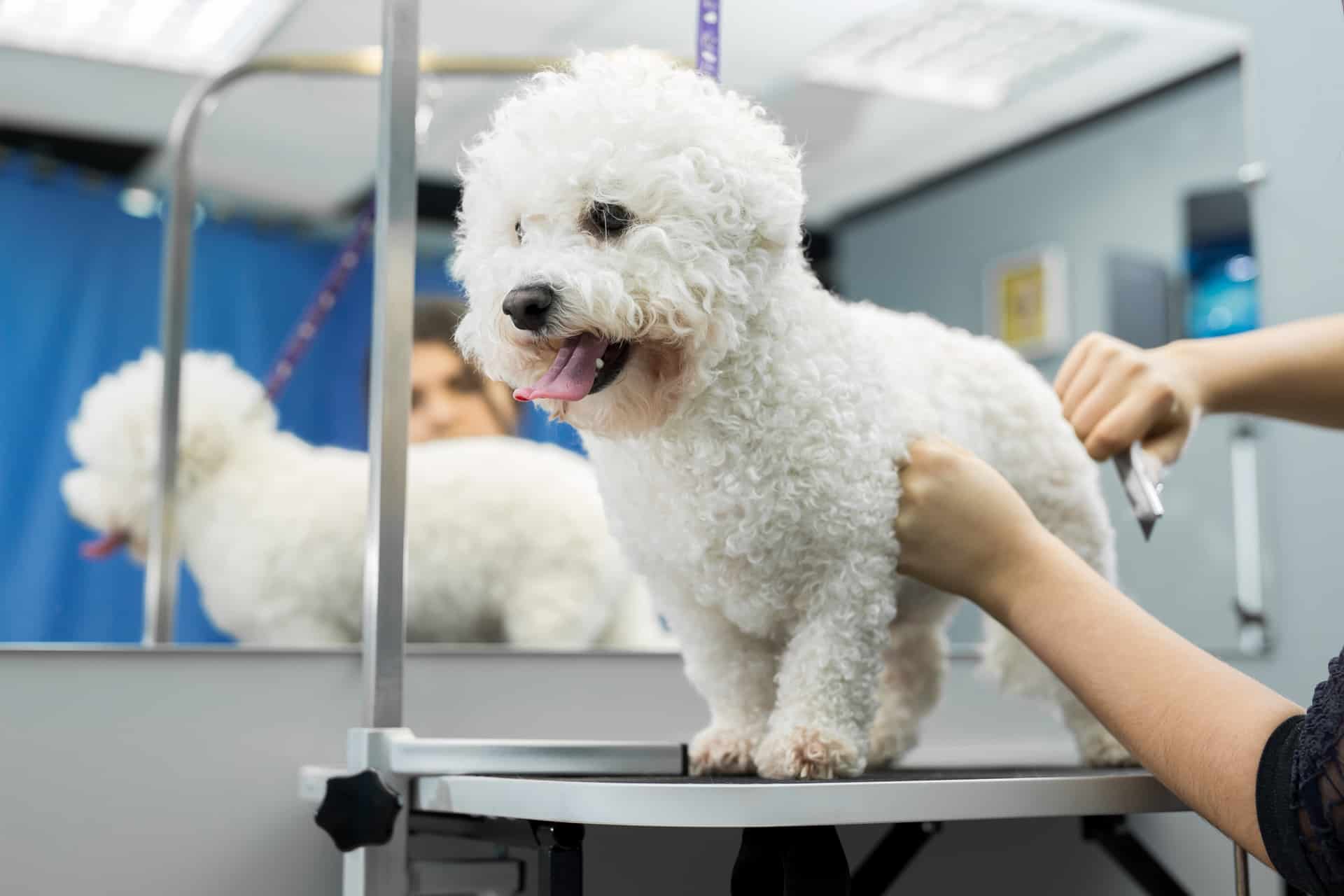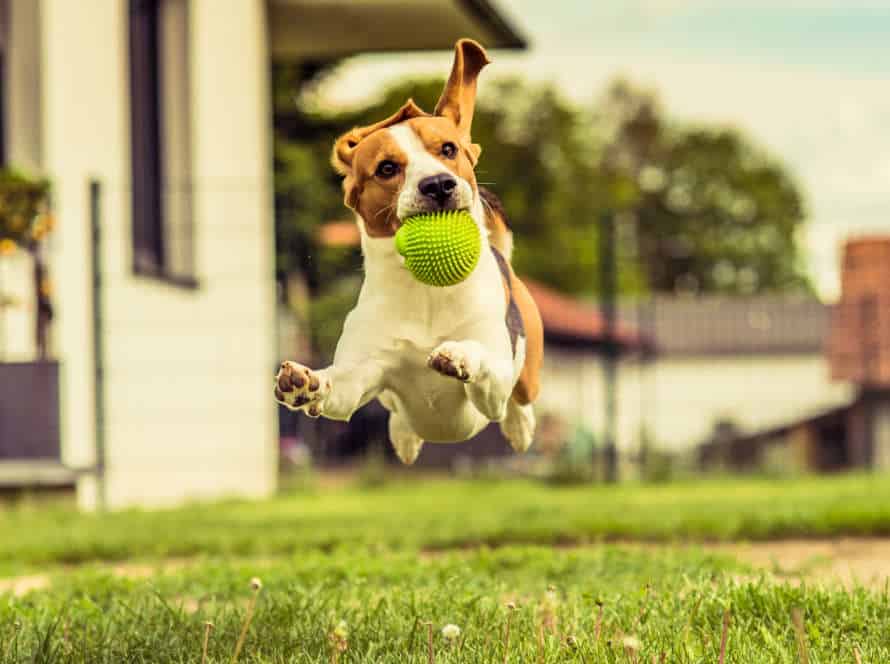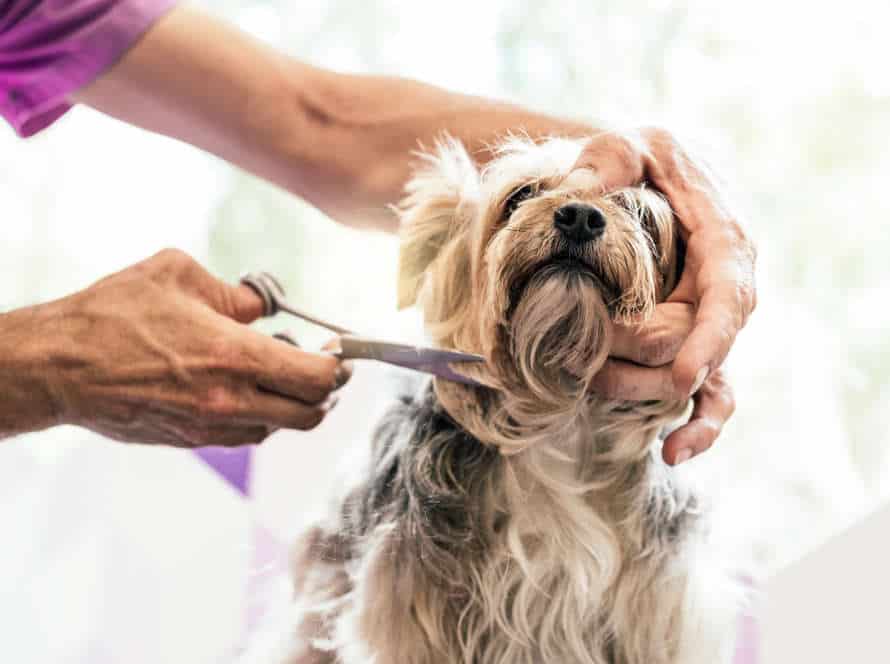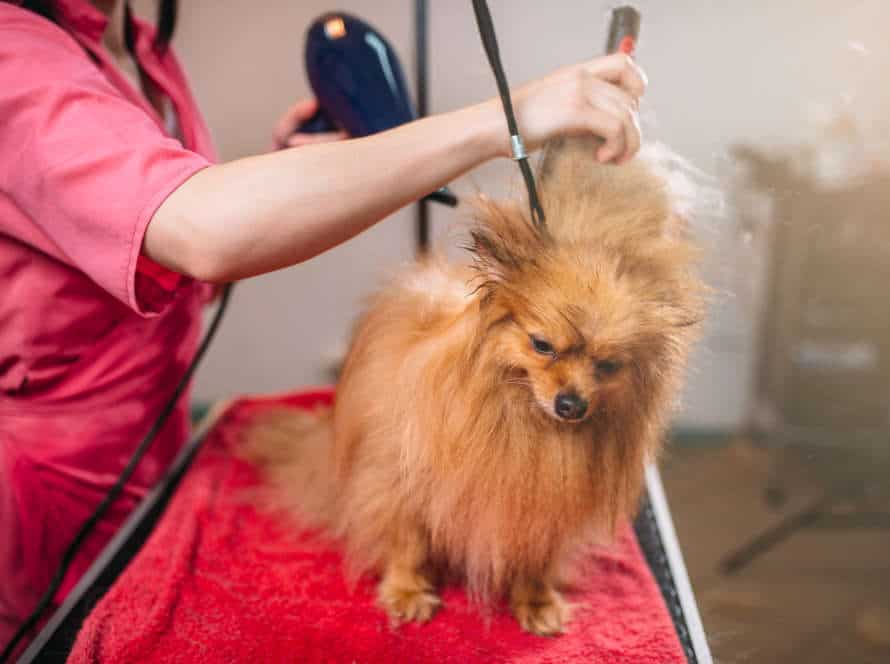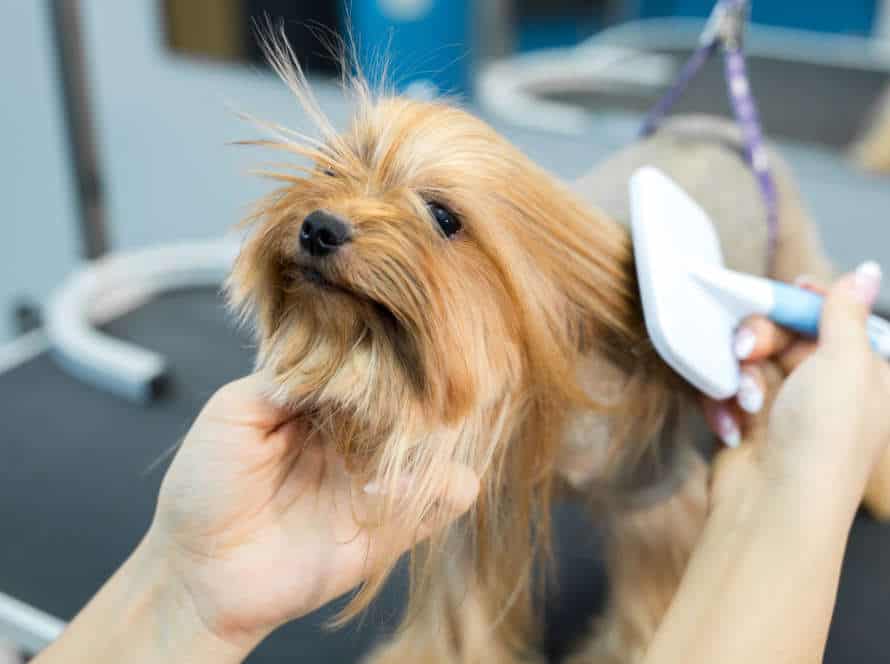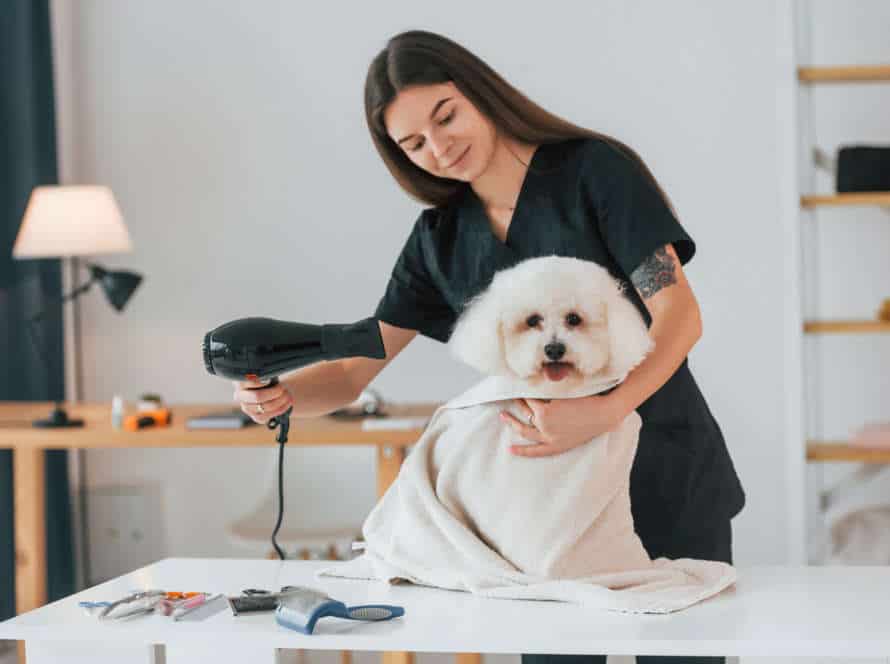Tips for Choosing the Right Grooming Tools for Your Dog
Choosing the right grooming tools for your furry friend is vital for their hygiene and wellbeing. To pick the perfect ones, here’s what to consider:
- Coat Type: What type of coat does your pup have? A slicker brush for long, thick fur. A bristle brush for short hair.
- Size: What size and weight fits your pup’s breed and size? Smaller tools for small pups to avoid injury.
- Purpose: Different grooming tools for different purposes. Trimming? Shedding? Cleaning ears and paws? Buy tools based on your doggo’s needs.
- Quality: High-quality grooming tools to last longer and be more effective.
- Caution: Dogs can be unpredictable. So be gentle while grooming and follow instructions carefully.
By following these tips, you can keep your pup happy, healthy and looking fab!
Understanding Your Dog’s Coat
Understanding your pup’s coat is the first step to selecting the right grooming tools. Different coats need different tools and methods. If you don’t know your dog’s coat, ask a professional groomer. Knowing the coat type is essential to finding the right tools.
Identify your dog’s coat type & texture
Identifying your pup’s coat type and texture is essential for selecting the right grooming tools and keeping their coat healthy.
There are four main types:
- Smooth-coated; short and glossy, minimal grooming needed.
- Double-coated; soft undercoat and thicker outer coat, shedding seasonally, regular brushing and grooming important.
- Wire-coated; rough and wiry, professional trimming required.
- Curly-coated; dense and curly, matting a risk, regular brushing and special attention to mat-prone areas a must.
Once you know the type and texture of your dog’s coat, you can select the right tools, like brushes, combs and clippers, to keep them looking and feeling their best!
Know your dog’s skin sensitivity levels
Knowing your pup’s skin sensitivity is essential for selecting the right grooming tools. Dogs with more sensitive skin need more delicate tools, to avoid irritation and discomfort. Here’s how to determine your pup’s skin sensitivity:
- Comb the fur to look for redness, bumps, or rashes.
- Observe your doggo during grooming sessions. If they seem uncomfortable or anxious, it could be due to skin sensitivity.
- Consult your vet if your pup has any skin allergies, so they can suggest the correct grooming products.
Once you’ve identified their skin sensitivity, choose grooming tools that match. For sensitive skin, use softer brushes, combs with round edges, and hypoallergenic shampoos and conditioners. Avoid using tools with sharp blades or bristles, as these can scratch or irritate the skin.
Determine whether your dog sheds or not
Figuring out if your pup sheds is a key part of understanding their fur and selecting the right grooming products to keep their coat healthy and clean.
Here are some tips to determine shedding:
- Look at their breed: Certain breeds like Huskies, Golden Retrievers, and German Shepherds are known for heavy shedding.
- Examine their coat: If you spot clumps of fur on furniture, clothes, or the floor, your pup sheds.
- Use a comb: Groom your pup with a comb and check for loose hair. If there’s lots of hair coming off, your pup sheds.
Which grooming tools to use on your pup also depends on their fur type, length, and texture. For shedding dogs, try an undercoat rake or shedding blade. For longer coats, use a slicker brush to prevent tangles. And for curly coats, opt for a wide-toothed comb.
Types of Grooming Tools and their Specific Purposes
Grooming your pup is essential for its well-being! But, it is important to pick the right tools. Different grooming tools exist and each has a purpose. Let’s discover the various types and their uses.
Combs
Combs are key for grooming your pup. They help get rid of tangles, mats, and shed fur. Plus, they spread natural oils throughout the coat. Different combs have different uses.
- Slicker comb: For dogs with medium to long hair, or curly coats. Remove mats, tangles, and fluff/style fur.
- Undercoat comb: For thick, double-layered, or heavy coats. Removes loose hair from the undercoat.
- Flea comb: Narrow teeth catch fleas, eggs, and dirt. Also good for ticks and other pests.
Choose a comb that fits the length/thickness of their coat, and their grooming needs. The right comb can make a big difference in the look and health of your dog’s fur.
Dematting Comb
A dematting comb is a must-have for dog groomers, especially for long-haired or thick-coated breeds. This comb can cut through mats, without damaging the skin or coat. Look for a comb with varied-sized teeth and a comfy grip. Using it regularly can keep your pup’s coat healthy and avoid needing more extreme grooming like shaving or clipping. But be gentle and only tackle small sections – avoid the sensitive areas such as around their ears, face and paws!
Flea Comb
A flea comb is a special grooming tool. It is designed for removing fleas and their eggs from your pup’s fur. The comb has close teeth to trap fleas and eggs. To use it, start at the top of your dog’s head. Comb through their coat and down the body. If you find a flea or egg, clean it off the comb with a tissue or paper towel. Dispose of it right away.
Remember, the flea comb is only one of many grooming tools. Consider your pup’s needs like hair length, coat type, and skin sensitivity before choosing a grooming tool.
Shedding Comb
A shedding comb is a grooming tool created for dogs with long hair or thick undercoats. Its purpose? To take away loose or dead fur. A shedding comb has short, close together teeth. These can reach deep into the coat for removal of fur, without harming the healthy fur.
When getting a shedding comb, consider the size and coat type of your pup. Large dogs with heavier coats need a larger head and longer teeth. Smaller dogs or those with fine hair should have a smaller comb with shorter, finer teeth.
Using a shedding comb regularly keeps your dog’s coat healthy and shiny, and reduces shedding in your home.
Brushes
As a pup parent, it’s a must to understand the different types of grooming tools and their purposes. When it comes to brushes, there are many options.
Slicker Brush: For medium to long-haired doggos, this brush is perfect for removing mats and tangles. It has fine, short wires packed together to grab and take out loose fur easily.
Bristle Brush: This is a classic grooming staple. It helps spread your pup’s natural oils and gives their coat a healthy shine. It also reduces shedding.
Pin Brush: This brush is best for long, silky coats. It has flexible bristles with rounded tips so it can remove debris, dead hair, and tangles without harming your pup’s skin.
Undercoat Rake: Great for breeds with thick undercoats, such as Huskies and Shepherds. It removes mats, loose hair, and tangles while protecting the topcoat.
It’s best to consider your pup’s breed, coat type, and grooming needs before buying a brush. That way, you can choose the right tool for your pup’s coat health and appearance.
Slicker Brush
A slicker brush is a grooming tool. It has fine, short wires close together on a flat surface. It can remove tangles, mats, debris and loose fur from a dog’s coat.
When choosing the right slicker brush, opt for one with fine, bent wire bristles. Think about the size of the brush in relation to your pup’s size. Don’t use a large slicker brush on a small dog.
Look for a slicker brush with a comfy handle. This will reduce hand and wrist strain during grooming. Plus, go for slicker brushes with retractable or removable bristles for easy cleaning.
Always use the slicker brush gently. This will help avoid hurting your dog’s delicate skin.
Pin Brush
A .2 pin brush is perfect for long-haired dog breeds, like Golden Retrievers, Afghan Hounds, and Cocker Spaniels. This type of brush helps remove tangles, mats, and loose hair from the undercoat.
When selecting grooming tools for your pup, take these tips into consideration:
- Think about your dog’s breed and hair type. Long hair may need a pin brush while shorter fur could just require a bristle brush.
- Pick out durable materials and comfortable handles. This will make grooming sessions more enjoyable for both you and your pup.
- Choose the right size. Small tools are better for smaller dogs and larger tools fit larger dogs.
- Remember to brush your pup regularly. This helps keep their skin and coat healthy, plus it’s great bonding time!
Bristle Brush
A 0.3 bristle brush is an ideal grooming tool for dogs with short hair and a smooth coat. When choosing the right grooming tools for your furry friend, consider the following tips:
- Coat type: Different coats need different tools. For instance, a slicker brush with fine teeth works well for long-haired dogs with thick coats. Whereas, a rubber curry brush is better for smooth-coated breeds.
- Size: The size of the grooming tool should be suitable for the size of your pup. A small slicker brush is good for toy breeds. Whereas, a larger one works well for Great Danes.
- Quality: Although cheaper grooming tools may seem attractive, investing in high-quality ones is more cost-effective in the long run and provides more comfort for your pup.
- Grooming needs: If your pup has matted fur or skin condition, choose a grooming tool that can address those particular needs, like a mat comb or a bristle brush.
Clippers
Dog grooming is crucial for your pet’s health and hygiene. Picking the right grooming tools is a must to get the best results. Clippers come in various types and shapes, each having its own purpose.
- Electric Clippers: These use electricity and typically come with changeable blades of different sizes, perfect for different coats and hair lengths.
- Cordless Clippers: These are battery powered and give more mobility.
- Manual Clippers: With a scissor-like system, these are ideal for grooming smaller dogs with thin hair or trimming near sensitive areas.
When choosing clippers, consider coat type, dog size, and precision you need. It’s smart to ask a professional for help in selecting the best tools.
Pro Tip: Clean and oil clippers after each use to keep them working well.
Cordless Clippers
Cordless clippers are the perfect grooming tool for convenience and mobility. They run on rechargeable batteries, no cords needed! Also, they make minimal noise, great for nervous pets.
These clippers provide precision and flexibility, perfect for light touch-ups around sensitive areas. When selecting a cordless clipper, consider your dog’s:
- Size
- Coat type
- Blade type
- Sharpness
- Motor power
- Speed
- Design features
- Accessory options
Take your time when investing in high-quality grooming tools for your pup. It’ll ensure a comfortable and efficient grooming experience for both you and your furry friend!
Single-Speed Clippers
Single-speed clippers are great for newbie dog groomers. They’re easy to use and affordable. Plus, they adjust to different hair thicknesses.
But, beware not to use them on dogs with heavy, matted fur or thick, curly hair. Multi-speed clippers are better in these cases.
It’s important to pick the right grooming tool for your pup. The wrong one could be uncomfortable or dangerous. Choose grooming tools that fit your dog’s breed and fur type.
Remember: Clean and oil your grooming tools after each use. This will keep them in top shape and working properly.
Variable-Speed Clippers
Variable-speed clippers are a must-have for dog grooming. They have multiple speed settings, perfect for different coat lengths and thicknesses. You can use them for face and body haircuts.
To pick the right clipper, consider factors like how often you groom, coat thickness, breed, and haircut style.
Here are some tips:
- Look for brands with quiet motors and multiple-speed settings.
- Check blade size and adjustability for different coats.
- Choose a model with comfortable grip and ergonomic design to prevent hand fatigue.
Factors to Consider When Choosing Grooming Tools
Grooming your pet is essential.
Selecting the correct tools to make sure safety and comfort are key. Countless grooming tools exist, so it’s important to pick the right ones for your canine!
Here are some of the key factors to consider when choosing grooming tools for your pet:
Your Dog’s Age and Temperament
Your pup’s age and nature are key when selecting the correct grooming tools.
Age: Pups have delicate skin, and may need milder tools for grooming. Older dogs may need special tools for matted fur and age-related issues.
Temperament: Anxious pups may need a slow introduction to the grooming process. Aggressive dogs may require specialized tools for safety.
Coat type, activity level and health concerns must be taken into account when selecting the right grooming tools.
Tip: Ask your vet or a pro groomer for advice on the best grooming tools for your pup.
Your Budget for Grooming
When shopping for your pup’s grooming tools, budget and pup needs must be considered. Here are some tips to help you select the right ones without breaking the bank:
- Coat type: Think about your pup’s fur type and pick tools accordingly. A slicker brush is great for long-haired pooches, while a comb is great for short-haired breeds.
- Noise level: If your pup’s scared of loud noises, get clippers with low decibel ratings.
- Durability: Investing in higher-quality, durable tools can save money in the future. They’ll last longer and need fewer replacements.
- Frequency of grooming: If you groom often, it makes sense to get high-quality tools that can withstand frequent use.
- Size of your dog: Smaller dogs may need smaller grooming tools, larger dogs may need bigger or tougher ones.
Your Level of Grooming Skill and Knowledge
Figuring out the perfect grooming tools for your pup demands that you understand your own grooming ability. Here’s what to think about:
- Coat type? Long-haired dogs need slicker brushes, while short-haired breeds need bristle brushes.
- Skin sensitivity? Dogs with delicate skin require gentle tools like rubber brushes, not harsh ones.
- Grooming frequency? Daily groomers need more specialized tools.
- Grooming experience? Choose tools that are easy to use and comfy in your hands. If you’re just starting out, start with a basic set and move up as you become more experienced.
Pro Tip: Get high-quality grooming tools for your pup – they must be safe and efficient.
Safety Tips When Grooming Your Dog
Grooming your pup is essential. Utilize safety measures when selecting the correct grooming tools. Here are some tips to consider:
- Clipper choice and shampoo selection should be done carefully. This is to guarantee your pup’s comfort and security.
Proper Use
Grooming tools must be used properly for your pup’s safety and comfort. Here are a few tips:
- Choose the right tools for coat type, size, and breed.
- Learn how to handle each tool, the angle to use, and which direction to brush or cut.
- Use clean and sharp tools – dull or dirty ones can hurt your pup.
- Be gentle, consistent pressure when brushing or cutting. Too much force can cause pain.
- Be careful around sensitive areas like eyes, ears, and genitals.
- Take breaks to keep pup calm.
- Reward pup’s good behaviour.
Pro tip: Regular grooming benefits physical health and strengthens bond. Take it slow and enjoy the process!
Avoid Cutting Your Dog’s Skin
Grooming your dog is important, but you need to be careful and not cut their skin. Here are some tips for finding the right tools:
- Pick the right brush: Long or curly fur needs a slicker brush, and short hair needs a bristle brush.
- Be aware of sharp edges: Grooming tools with sharp edges near their face, ears, or paws can be dangerous. Pick tools with rounded or blunt edges instead.
- Go for scissors with a rounded tip: Scissors make it easy to trim around sensitive areas, but make sure the tip is rounded to avoid poking.
- Use the right size tool: Oversized tools can make it hard to groom properly and increase the risk of cutting their skin. Get tools that fit your dog’s breed and size.
Remember – keep styptic powder or cornstarch on hand if your dog gets cut accidentally. With these tips, you can keep your pup safe and comfortable while grooming!
Use Caution When Grooming Sensitive Areas
When brushing your pup, care is key! You don’t want to cause pain, discomfort or injury. So, here are some safety tips:
- Buy good grooming tools. Pick ones that fit your pup’s coat and size.
- Don’t use scissors or clippers in sensitive spots. Choose combs, brushes or grooming gloves instead.
- Go slow! Start with less sensitive areas, then work your way to the ears, paw pads and tail.
- Check for skin irritation. Look out for redness or inflammation.
Follow these tips to keep your pup happy and safe while grooming!
Where to Buy Grooming Tools
Groom your pup with the best tools! Find them in pet stores or online. When you purchase these tools, make sure they work for your pup. Do your research to get the best tools and prices. Here are some tips for choosing the right grooming tools:
- Consider your pup’s coat type and length when selecting brushes, combs, and clippers.
- Choose high-quality tools that will last longer and perform better when grooming your pup’s nails, teeth, and ears.
- Look for grooming tools with features that are easy for you and your pup to handle and use comfortably.
- Seek advice from other pet owners or a professional groomer to help you choose the right tools for your pup.
Local Pet Stores
Head to your nearby pet store for all your pup’s grooming needs! Here’s what to keep in mind:
- Select items that fit your dog’s size, coat type, and grooming needs.
- Look for quality products that will last.
- Your budget matters, but don’t skimp on quality!
- Seek the advice of a pro groomer or vet if you’re unsure.
- Brush, comb, nail clipper, and shampoo are must-haves.
- Remember to clean and maintain your tools.
- Local pet stores have a wide variety and staff to help you pick products. Plus, don’t forget to give Fido a treat after grooming to reward good behavior!
Online Stores
When searching for grooming tools for your furry companion, online shops offer plenty of choices. It’s important to take into account some tips to guarantee you pick the perfect grooming tools for your pup.
- Size, breed, and coat type of your dog must be taken into account before buying grooming tools online. For example, various brushes are created for different coat types, and selecting the inappropriate one could end up harming your pet’s coat.
- High-quality tools that are strong and made from non-toxic materials should be sought.
- Always read reviews and examine the ratings of the store before making a purchase.
Popular online stores to buy grooming tools for dogs include Chewy, Petco, and Amazon.
Shopping online for grooming tools is not only convenient but also gives access to a wide selection of products that might not be accessible in stores.
Specialty Grooming Stores
Specialty grooming stores are the ideal spot to buy tools for your pup. They carry a wide selection of grooming tools and products. Their team knows the best tools for different doggy breeds and coat types. When picking the right grooming tools, keep these tips in mind:
- Pick brushes and combs based on your pup’s coat length and texture. A slicker brush works best for long-haired dogs. While, a bristle brush is better for short-haired dogs.
- Use a shedding blade to remove loose hair and undercoat from double-coated breeds like German Shepherds and Huskies.
- Choose nail clippers based on your pup’s size and nail thickness. Guillotine-style clippers work better for small breeds. Scissor-style clippers suit larger breeds.
- If you’re unsure, talk to a professional groomer. They can give tailored advice and recommendations.
This highlights the importance of finding the right tools for your pup. Specialty grooming stores have a wide selection of grooming tools and products, which have been recommended by their team who knows the best tools for different doggy breeds and coat types.
Frequently Asked Questions
1. What are the most important factors to consider when choosing grooming tools for my dog?
When choosing grooming tools for your dog, it’s important to consider factors such as your dog’s breed, coat type, and the specific grooming needs they may have. Additionally, you’ll want to look for tools that are safe and comfortable to use, as well as durable and easy to clean.
2. How do I know if a grooming tool is safe for my dog to use?
Before using any grooming tool on your dog, it’s important to read the manufacturer’s instructions carefully and familiarize yourself with any safety warnings or precautions. Additionally, you may want to consult with your veterinarian or a professional dog groomer to ensure that you’re using the right tools and techniques for your dog’s specific needs.
3. What are some common types of grooming tools?
Some common types of grooming tools include brushes, combs, clippers, and scissors. Different tools may be designed for different purposes, such as removing loose fur, detangling mats, or trimming hair in specific areas.
4. How often should I groom my dog?
The frequency with which you should groom your dog will depend on their breed, coat type, and specific grooming needs. In general, dogs with longer hair or thicker coats may require more frequent grooming to prevent matting and tangling, while dogs with shorter hair may require less frequent grooming. Consulting with your veterinarian or a professional dog groomer can help you determine a grooming routine that’s right for your dog.
5. Can grooming tools help prevent skin and coat problems in my dog?
Yes, regular grooming can help prevent skin and coat problems in your dog by removing debris, mats, and tangles that can trap dirt and bacteria against the skin. Additionally, using the right grooming tools can help distribute natural oils throughout your dog’s coat, keeping it healthy and shiny.
6. How can I tell if my dog doesn’t like a particular grooming tool?
If your dog is uncomfortable or hesitant around a particular grooming tool, they may exhibit signs of anxiety or distress, such as whining, panting, or pulling away. If this happens, it’s important to take a step back and reassess how you’re using the tool, and consult with a professional if necessary to ensure that you’re using the right tools and techniques for your dog’s specific needs.

